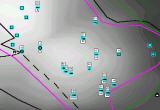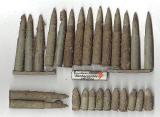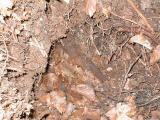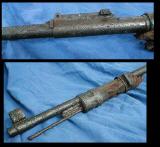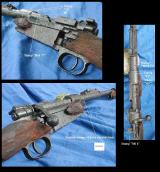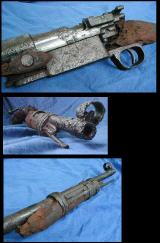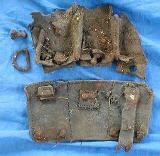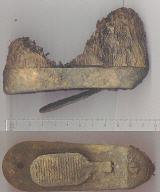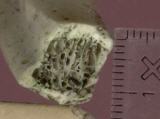World War 2 on skull hill (9/15)
World War 2 on skull hill
We have reached the last destination of our journey through time. From the depths of time we have emerged to reach a period with eyewitnesses still among us.
The revolvers mentioned above were likely hidden immediately after WW 2 ended. As mentioned in part 1 people were prohibited to own firearms so many went into the nearest forest and hid whatever they had.
Researched WW 2 incidents led us to this hill. The historical background was described in part 1 of this account. Here it is sufficient to say that troops of a German SS division, decimated by heavy fighting, received order on May 3, 1945 to take positions on that hill to prevent US military to pass through the valley. The stayed on that hill from May3 or 4 to May 7. On May 7 they went into US captivity or tried to make their way home..
Lets see whether this research is confirmed by our finds.
A look at the map tells us we are at the right spot. There are several foxholes (blue squares). They are located to control the main road (the direction from which the enemy was expected) (right), the high ground (center), and the small forest way (left center).
Note that all foxholes are placed on the same side of the small way so the soldiers do not endanger each other when they shoot at an approaching enemy. I think these foxholes were the center of the military position while the others faces the enemy.
At the beginning I said I assumed a heavy gun position near the main road, .i.e. the eastern end of this map. I did not find any evidence for this, just two foxholes.
US bullet
There was hardly any fighting on skull hill. The found evidence is in compliance with the written sources. It seems the Germans did not fire a single shot from that hill. One possible exception is an empty flare gun cartridge (#57) but it is uncertain that it originated from WW 2.
On the other hand the Germans received some very limited fire. Find # 47, a lonely find in the far west, is a fired US 0.3” projectile. The black head marks the armor piercing version with steel core.
Find # 47. WW 2. US 7.62 mm AP projectile.
Detail Map
Here a detail map of the eastern parts of the hill is provided where most WW 2 finds were located. These items will be discussed in the following.
Grenade fragments
The Germans were shelled with one single grenade. Find # 58 at he south eastern slope, near the top, is a grenade fragment. I found several fragments. Most of them are not marked on the map since I considered them rubbish at first. Now I wish I had all positions. Possibly the distribution pattern would have allowed to determine the direction of the gun.
Picture shows WW 2 Grenade fragments. E.g. find # 58
German live small arms ammo
At the southern slope, near the top, several empty German K98k carbine cartridges were found. Finds #52 to # 54 None of them was fired. Did someone pull out the bullets? The reason for this find is unclear.
The finds #12, #14, #49, #59 are complete K98k cartridges. At the lower end of the slope the layer of soft ground was thicker than on the slopes. So the ammunition was discarded there. Most finds are multiple finds.
Find # 46 comprised some 10 pistol cartridges 9 mm. Unfortunately, the pistol was nowhere to be found.
The picture shows ammunition finds # 46, #12, #14, #49, #59. AA cell for size comparison only.
The shown ammunition was handed over to the police.
More interesting than discarded ammunition is intentionally hidden equipment. Skull hill offered several items of that kind.
Luftwaffe belt buckles
#2 is a hidden German WW 2 air force belt buckle accompanied by pieces of an assault harness. It was hidden some 30 cm / 12” deep at the base of the tree in the centre of Fig. 3.
Later I found a second air force buckle complete with leather belt immediately under the leafs. Here are both buckles.
Picture shows German air force belt buckles. Find # 22 (left) and # 2
Luftwaffe belt
Two objects of the same kind hidden in the same ground for the same length of time but still very different condition. Can you guess which one was hidden in the ground and which one was nearly on the surface? Right, the better one #22 was on the surface. I made this experience again and again. My personal theory for this observation is that objects on the surface are exposed to humidity for shorter periods of time than those hidden in the ground. This leads to less corrosion and better condition.
Picture shows remains of the leather belt of a German airman.
K98k rifle
At the base of a tree I got a big iron signal, some 1 m / 1.1 yards long, oblong, and thin. Under 20 cm / 8” of leaves and a similar layer of soil I felt a tube shaped iron object. There is just one thing that feels like the barrel of the gun and that is a barrel of a gun. She seemed to say “Where have you been? I waited so long, 6 decades. “ I murmered an excuse and carefully removed the object. It was a German WW 2 carbine K98k complete with all metal and leather parts.
First Sight
Here the rifle sees the first light after 6 decades.
Find State
My first K98k! Until then I had found several rifles but never the standard weapon of the German soldier in WW 2. Maybe this weapon symbolizes more than any other model the German infantry in this conflict.
When it was out of the hole I re-checked for more metallic items. So I found the buttstock, some more iron pieces and, by chance, the leather band.
Picture shows the find state including leather band, buttstock and small iron parts. As with the belt buckle #22 the leather condition is remarkable good.
Rifle Cleaned State
This is the condition after careful mechanical cleaning. So many remaining wooden parts are unusual. It seems all substances benefit from the chemical conditions on that hill.
K98k view 1
Views 1
K98k view 2
Views 2.The weapon carries many stamps.
K98k view 3
Views 3. Note how different corrosion took its toll on different parts of the weapon. Near the muzzle it corroded while parts of the receiver kept their original surface.
K98k ammo bag
The next day I found the remains of a K98k leather ammo bag just a few 10 meters down the hill.
Picture shows find # 18. Remains of German WW 2 leather ammo bag. It once stored 15 rounds for the K98k
Buttstock
Find # 21 is the buttstock plate of a German K43 or G43 rifle. Unfortunately, the rest was not found. The find shows that on that hill weapons were not only hidden but also destroyed.
Buttstock plate German G43 or K43 automatic rifle.
Combat knife find state
Find # 23, made some 5 meters / 5.5 yards below a foxhole, is one of my favourites. It is a US WW 2 combat knife. It is named Kabar knife after the manufacturer which still exists today. Total length 30.6 cm / 12”, blade length 18 cm / 7”.
Combat knife cleaned
Cleaned state.
Knife front
Blade.
Knife handle
The knife was hidden some 40 cm / 16” deep. The condition, especially of the leather handle, is excellent. This is surprising since the ground was dry. When recovering leather finds it is important to treat them quickly with weapon oil. Otherwise they will dry out and flake.
How gets a US knife into a German position that never saw combat? Since the knife was most likely hidden intentionally I think it was concealed by a German soldier who wanted to avoid unpleasant questions in US captivity. How he got it can only be guessed.
Rib bones
Some 10 m / 11 yards away I found two rib bones which I thought belonged to a big deer. When I took them both fragments were some 20 cm / 8” long.
Conclusion WW 2
To sum it up, the found WW 2 relics tell that much.
German soldiers were present at that place. The research was correct. The Germans did not fire small arms. They received very limited enemy fire. The number of German soldiers on that hill can only be roughly guessed. 50 men can dig the foxholes in one day. The found relics did not suggest the presence of more than 2 men (2 belt buckles found). In total, I have the impression that a larger group of men dug the foxholes but did not spend 4 days and nights on that hill. Apparently the hill was apparently occupied by just a few men. The rest of the unit slept probably in the village.
Research indicated that SS men were on that hill. I did not find a single SS specific item though. The belt buckles belonged to the air force.
(C) Thorsten Straub www.metal-detecting.de 2006-2019.


